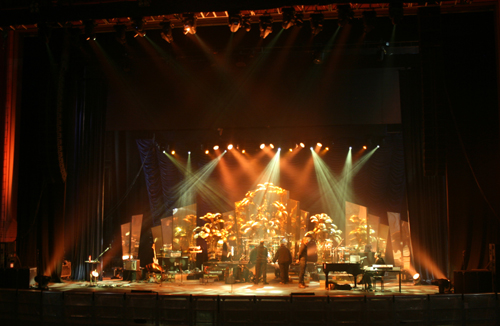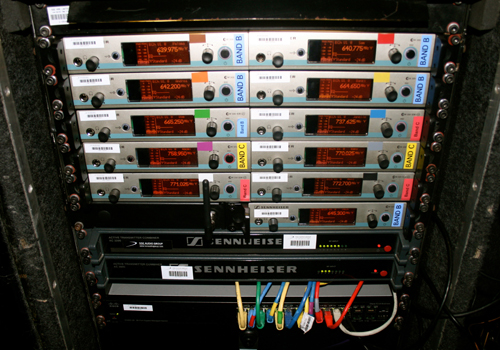
“I mix very hands-on – like an instrument, really – and this console allows me to do that,” Richards continues. “We use snapshots for faders and mutes, but that’s all.”
Perttu Korteniemi of SSE, the tour’s system tech, always gets to the venues early (“with the lampies,” he notes, grinning) to ensure all of the array hang points are in the right place.
“I tend to work from a blank canvas every day, though I’ve been here at the Apollo before, so I had the room file, which made things a bit easier,” he says. “I use L-Acoustics SoundVision software 3D prediction software, and it’s excellent, though there’s no wizard element to it.
“A lot of this stuff is IP-based now. If you have the dimensions of the room and good drawings, you can do a lot of prep work, which obviously gives you an advantage,” he continues. “With this (KARA) system, we only need two local crew members to hang it, because once propagated, it goes up so quickly. And after the show, the boxes are often down before the drum kit is, which is pretty incredible.”
It also points to the radical changes currently underway in live sound reinforcement. This was further reinforced as Korteniemi showed me the system racks, noting that the signal path stays digital in traveling from the SD Rack to the SD10 to Lake processors at front of house and at the stage, all the way through to the LA-8 amplifier controllers.
“When the microphone and line level inputs hit the SD Rack on stage, their signals don’t go back to analog until it hits the speaker cables,” Richard says. “This method keeps it all simple, and level-wise, if it’s the input coming in and all faders are at zero, there’s no setting up of gains and no hiss. It’s all nice and clean, so when you open up the PA, there is no interference whatsoever.”
Technically Flawless
At the monitor position, Saul Skoutarides works from a packed-out Midas PRO2 console, utilizing 54 channels and eight auxes in providing mixes to eleven Sennheiser G3 in-ear monitoring systems utilized by Faith and her backing band. Stage fill mixes are also supplied to L-Acoustics ARCS positioned to each side of the stage.
“I used to use G2s, which were great, but these G3s have better stereo imaging, better RF, better gain structure, and a better sound board. They’re the best system out there right now,” Skoutarides states.
Faith favors a Sennheiser MD 5235 dynamic microphone element on an SKM 5200 mk II handheld transmitter for her vocal, which Skoutarides paired with a Sennheiser EM 3732 wireless receiver.
“The 3732 has an AES output, which is great if you want to keep it digital all the way,” he says. “It’s in the ultra-wide NGB range, which goes from 606-790 (MHz), so I can also use it as a scanner for the entire band, because my in-ear systems also fall into that band. That’s a real treat.”
The Apollo show in its entirety also proved a treat, with the expert work of the sound team resulting in a technically flawless audio production. Credit should also go to Paloma Faith – this is an artist that knows what she wants, from the set to the set list, and the show oozed meticulousness. A capacity crowd went home very satisfied after witnessing a concert that sounded every bit as good as it looked.
Paul Watson is the editor for Europe for ProSoundWeb and Live Sound International.


